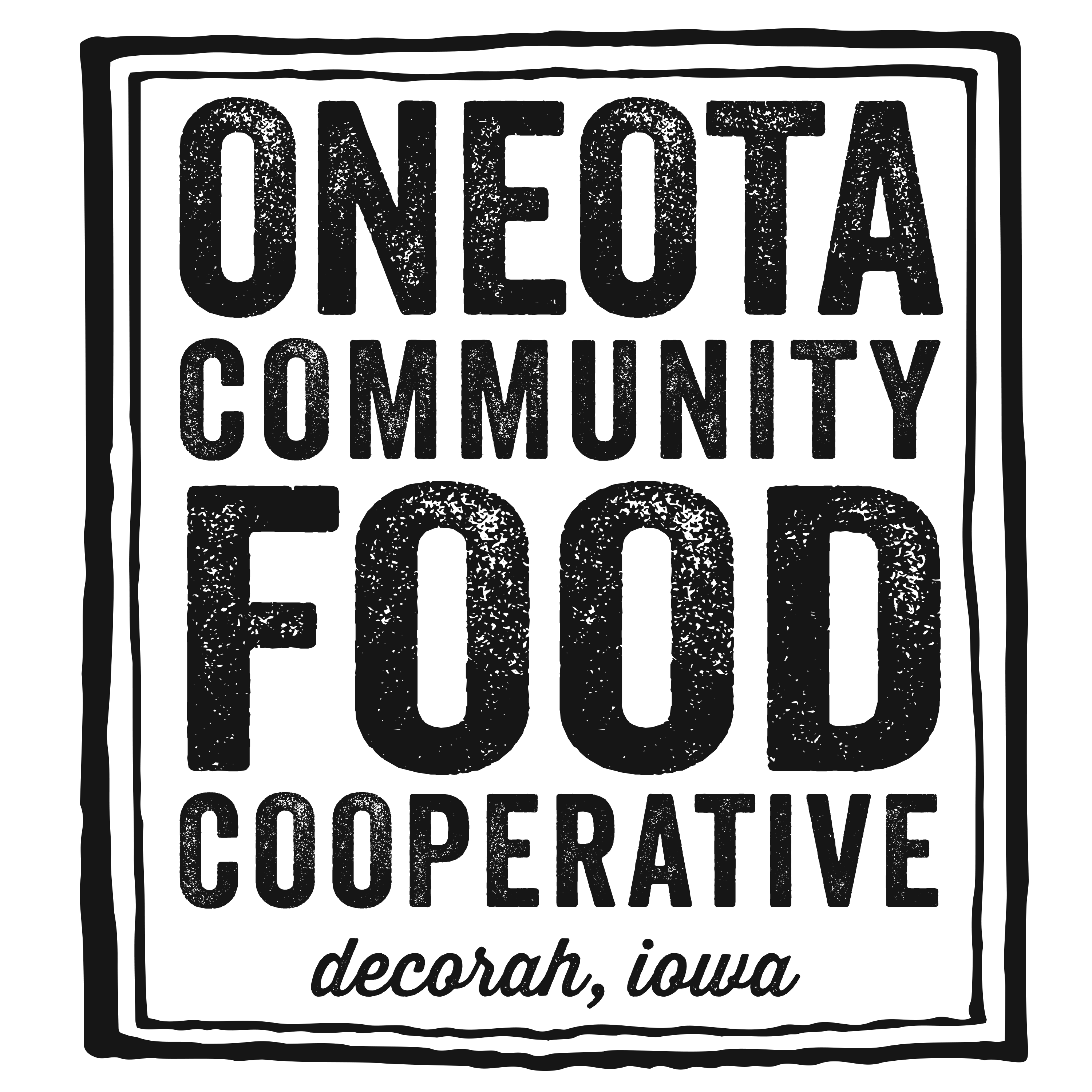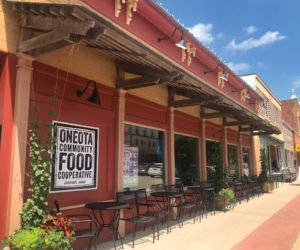Rooted & Growing
By Cerrisa Snethen, Working Member Coordinator
How can we know where we’re going if we don’t know where we’ve been? Taking a look around our shiny, modern co-op, it’s easy to forget the store’s humble roots. But without remembering, protecting, and watering those roots, we risk a great deal as an organization. In this era of the corporation, of privatization, in this era of recession, co-ops are somehow thriving nationwide. The idea of a democratically owned and operated local business seems to have breathed new life into a tired model. And as we grow, one of our most important missions, as always, is holding onto the early passions that drove the Co-op’s creation. Some would call it soul, hence cooperative grocers across the nation are giving a whole new meaning to the term soul food.
It wouldn’t be authentic to hint that our own co-op hasn’t had its individual crisis of soul, its moments of folly and sorrow. However, as we forge ahead in a direction that’s full of positivity and possibility, it’s important to look back in a spirit of grace and gratitude for the ones that paved way for our community to hold such a precious and unique place, and to acknowledge their hard work, sacrifices, tribulations, and triumphs. So, we’re kicking off a series of articles on the Co-op’s pioneers. This article will not be all-encompassing of those who started it all. We hope to touch on more individual efforts in pieces to come.
Without further adieu, the story of Sheryl Scheffert:
Born in Chariton, Iowa, and raised in Erie, Illinois, where the family moved when she was six, Sheryl’s Decorah story takes off at Luther College, where she studied music and met her now husband Rick, then a young art student. In a way, Sheryl’s co-op tale is really a love story. She attributes her earliest Co-op affiliations to her husband and his strong interest in those early principles. Sheryl told me how she “really liked” Rick’s perspective on food, health, and community. So, she joined up with him as a working member at a time when the Co-op was just a little shack-like building on Paine Street. In those days, the store had only volunteer employees, the food was stored in bags inside (clean) garbage cans, and a very modest and barely working refrigerator stored perishables. Sheryl went on to become one of the Co-op’s first ever paid managers, overseeing volunteers and working at the store during it’s unusual and variable business hours. When she landed the managing gig in 1979, it was the same year the Co-op got it’s first digital scale and “cash register,” which actually just consisted of a cash box and an adding machine. This was also the first year the Co-op began selling to non-members. Sheryl went on to play an important role in the Co-op’s developing history. Ah, the things we do for love.
Having initially grown out of a buying club, the Co-op at this point charged members a $10 annual membership fee, much different from the member/owner share system of today. Things were really picking up steam in moving to a store front, but the small space had it’s humble quirks. The key to the store was kept out in a wood shed where it could be easily found. Members would often let themselves in at odd hours and simply leave behind payment using an honor system. The little building ran on a tricky wood stove with an overnight oil stove back up, and the day’s money was inevitably hidden in a food bin one could only locate by reading the store’s “short list.” Employees knew to identify the last item on the list to locate the store’s cash in that particular food bin. Back then it was mostly grains and dried goods with the occasional arrival of cheese or goat milk.
Having outgrown those first digs, the Co-op moved to the Armory building while Scheffert was pregnant with her first child, daughter Jeanine (currently an active Co-op member and local artist). In fact, when I asked Sheryl if she had co-op related photos of this time, she said “Actually, Jeanine was born right around that time, so you know who all the pictures are of!” Now in the Armory building, Sheryl remembers this location being much bigger and cleaner, which was a good incentive to lug all of those fifty pound bags up several flights of stairs. With things growing so quickly at this point, I asked Sheryl how the group managed conflict. She let out a long sigh accompanied by a laugh. “Huge discussions,” she said “Lots and LOTS of meetings! We’d have a gagillion meetings, and then… we’d vote.” During this time, there was always a general meeting of the members in addition to a board meeting, and members could overturn whatever the board decided to do. Sheryl explained how this sometimes caused controversy and made board members feel a bit weary that their decisions could be so easily overturned by the membership.
The group worked out differences as democratically and fairly as they could, and in 1981 the board accepted a proposal for collective management, consisting of Sheryl Sheffert and Jo Berg-Iverson, Beth Rotto, Ann Edgerton, and Jean Young. Members of the management collective earned $8 per day. This was also the year the Schefferts welcomed their son Luke, who now lives in Florida. The store now sold more dairy and cheese in addition to herbs and spices, but while everyone was welcome to shop, getting them there required directions and was often the result of word-of-mouth contact since the store still lacked visibility.
The following year brought Steve McCargar into the management fold, and the Co-op increasingly focused on the goal of educating the larger Decorah community about food and sustainability issues. Because members shared common interests, you’d often find them spending non-working hours together too, with potlucks and singing; with all of that eating and singing it was impossible for Oneota Co-op members not to maintain a strong community presence. Sheryl emphasized that these social functions looked much like the Co-op related social functions of today. “It felt like a big family, but nobody tried to force their way of doing things on others. We were supportive of each other.” And things just kept growing. In the spring of 1984 the Co-op moved into a much more visible location at 521 West Water Street. During the time the Co-op was in this location, Scheffert took on less and less hours and eventually stopped working in a paid position for the Co-op. She’d moved on to a career in teaching music to children which would last for more than twenty years. Her family remained active in Co-op culture.
While in this space, the Co-op would see dramatic changes– the additions of Liz Rog and Sue Otte to the management collective, the change to share payments for members, and the store’s first electronic cash register. With new structures in place and a more prominent location, the Co-op was receiving more traffic from the general public and was often seen as a place to go for specialty items. The store would move once more just down the street from this location before winding up in it’s current home at 312 West Water. Was all of this moving difficult? I wondered. “I think it’s always tough when you’re borrowing,” emphasized Sheryl about all of the financial risk early members were taking. There were also the inevitable questions of whether all of this growth would hinder something so well-intentioned. With each move, Sheryl said members were often asking themselves “How much do we lose of our identity?”
While questions of conscience abounded, so did a lot of wonderful things– like produce. “We had tons more produce”, Sheryl said “I loved that!” She recounted being in the store during the holiday season one year, when Steve McCargar approached and exclaimed “We had used to take a month to earn had suddenly taken less than 24 hours. Things were really catching on. I asked Sheryl what it’s been like to watch “green” become a buzz word and the Co-op become a hip hang out, to have been a part of the Co-op before the co-op was cool.
“Yeah,” she smiled. “I love walking by the store now and seeing all of the young people hanging out… just hanging out.” Sheryl went on to tell me more about what she finds inspiring and positive about the store these days. She praised cooperatives and talked about the exciting dynamic that they bring, even with their inevitable highs and lows. She loves that the store brings an alternative to the community and that it’s a locally owned business, a model and a leader in the realm of health, and, overall, a caring community. “We weather the storms,” she said. “And we do it together”.
Having watched the fledgling organization fight to garner credibility and respect in the community, Scheffert is thrilled to see the Co-op’s values and principles being more accepted by the mainstream. What was then an eye-raising concept now seems to incite excitement and acceptance, particularly from the young people in Decorah. I asked Sheryl what we can do as a community not only to keep the Co-op, but (most importantly) also to see it thrive. “Shop there! That’s the most important thing of course. It has to be important to us.” Not only does Sheryl still shop co-op, she’s an active working member who pitches in to help with inventory when she can, alongside husband Rick.
These days she frequents the store’s bulk section and adores local produce and local products in general. She loves and prefers the Co-op’s organic produce and products but is glad that the store offers several options. Sheryl believes that organic is worth it’s value in terms of ecology, health, and taste. I wondered what she might say to someone who was on the fence about joining up. “My inclination would be to take them into the Co-op and possibly even buy them something.”
Bribery? I wondered. “Bribery!” she laughed. “No, but I’d want to say… taste this apple… just… taste it!” We explored the notion that some folks have an image of the Co-op as an unfriendly or exclusive place. With a sigh Sheryl noted that those with that idea probably just haven’t been able to spend much time with us at the Co-op, which she feels is an extremely friendly and welcoming environment. She went on to sum things up eloquently (despite her insistence she wasn’t). “We’re on a journey that embraces food, health, and community, and no matter what the pitfalls, it’s a journey worth continuing. In my experience the Co-op has always been home to passionate and dedicated people, with an energy and determined drive toward goodness and groundedness that speaks to me. Sometimes independent passions and opinions clash, but the dialogue created by the clash is always worth having.”
I asked Sheryl before she left if she could go back in time to 1979 and be there with that gang, what would she say to their younger selves? “Follow the dream,” she affirmed. And if she could say anything to that same gang now, all these years later? “Look,” she smiled “Look what we’ve helped create. It’s pretty amazing.”



